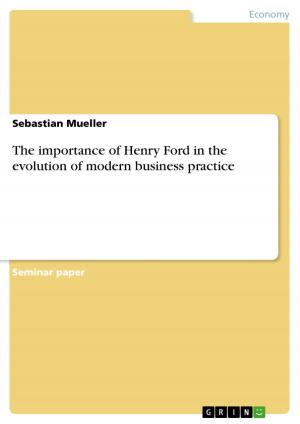Who Killed Willy Loman? An Investigation into Arthur Miller's 'Death of a Salesman'
Fiction & Literature, Literary Theory & Criticism, British| Author: | Anonymous | ISBN: | 9783638506472 |
| Publisher: | GRIN Publishing | Publication: | May 30, 2006 |
| Imprint: | GRIN Publishing | Language: | English |
| Author: | Anonymous |
| ISBN: | 9783638506472 |
| Publisher: | GRIN Publishing |
| Publication: | May 30, 2006 |
| Imprint: | GRIN Publishing |
| Language: | English |
Seminar paper from the year 2003 in the subject English Language and Literature Studies - Literature, grade: 1,3, University of Freiburg (Englisches Seminar), 8 entries in the bibliography, language: English, abstract: When Willy Loman is heard racing off with his car at the end of Arthur Millers play Death of a Salesman, nobody doubts why he is doing so. He wrecks his car and kills himself to leave his family 20,000 dollars insurance money. Willy Loman is a suicide. And yet every viewer of the play will ask himself1who or what killed this man. What are the forces that pushed him towards this somber end? The fact that Arthur Miller pursues genuine moral education in his plays, which he has repeatedly admitted to (for example in 'The Salesman Has a Birthday') justifies this question. For how one answers it decides what kind of message one distils from the play. In this paper, I will not focus on a possible moral message of the play. Instead, I will try to collect hints at who or what might be responsible for Willy Loman's death. As I am not the first to engage in this matter, I will be able to present the viewpoints of different critics, and to compare them. It seems to be a characteristic ofDeath of a Salesmanthat many reasons can be named for its catastrophic ending - its discussion has been very controversial. In consequence, one difficulty of my investigation will be to take into account also the play's subtleties in order to value each critic's standpoint properly. It has repeatedly been criticized that Arthur Miller makes use of fuzzy logic in his play. On the one hand, one can see obvious traits of social criticism inDeath of a Salesman,on the other hand Miller presents two characters - Charley and Bernard - that succeed in a capitalistic world without acting unfair. Miller condemns a social order ruled by wealth while approving of the right way to live in it. This conflict demonstrates that Miller's play is offering explanations of Willy Loman's failure that are based on social criticism as well as explanations that are psychologically motivated. This division marks the two directions criticism has been following through the years. For that reason, I will divide my inquiry into two sections: Cultural Reasons and Psychological Reasons. Whenever necessary, the two domains will be cross-linked in order to form a synthesis. When verifying quotations fromDeath of a Salesman,I will use plain numbers in brackets, such as (2031).
Seminar paper from the year 2003 in the subject English Language and Literature Studies - Literature, grade: 1,3, University of Freiburg (Englisches Seminar), 8 entries in the bibliography, language: English, abstract: When Willy Loman is heard racing off with his car at the end of Arthur Millers play Death of a Salesman, nobody doubts why he is doing so. He wrecks his car and kills himself to leave his family 20,000 dollars insurance money. Willy Loman is a suicide. And yet every viewer of the play will ask himself1who or what killed this man. What are the forces that pushed him towards this somber end? The fact that Arthur Miller pursues genuine moral education in his plays, which he has repeatedly admitted to (for example in 'The Salesman Has a Birthday') justifies this question. For how one answers it decides what kind of message one distils from the play. In this paper, I will not focus on a possible moral message of the play. Instead, I will try to collect hints at who or what might be responsible for Willy Loman's death. As I am not the first to engage in this matter, I will be able to present the viewpoints of different critics, and to compare them. It seems to be a characteristic ofDeath of a Salesmanthat many reasons can be named for its catastrophic ending - its discussion has been very controversial. In consequence, one difficulty of my investigation will be to take into account also the play's subtleties in order to value each critic's standpoint properly. It has repeatedly been criticized that Arthur Miller makes use of fuzzy logic in his play. On the one hand, one can see obvious traits of social criticism inDeath of a Salesman,on the other hand Miller presents two characters - Charley and Bernard - that succeed in a capitalistic world without acting unfair. Miller condemns a social order ruled by wealth while approving of the right way to live in it. This conflict demonstrates that Miller's play is offering explanations of Willy Loman's failure that are based on social criticism as well as explanations that are psychologically motivated. This division marks the two directions criticism has been following through the years. For that reason, I will divide my inquiry into two sections: Cultural Reasons and Psychological Reasons. Whenever necessary, the two domains will be cross-linked in order to form a synthesis. When verifying quotations fromDeath of a Salesman,I will use plain numbers in brackets, such as (2031).















